Key takeaways:
- Re-engagement campaigns focus on fostering emotional connections and reminding customers of their past experiences with a brand.
- Personalization, exclusivity, and timely communication are crucial strategies for successfully re-engaging customers.
- Utilizing marketing automation tools and CRM software enhances the effectiveness of re-engagement efforts by targeting customers based on their behaviors.
- Measuring success involves analyzing open rates, customer feedback, and conversion rates to gauge the impact of campaigns beyond immediate sales.
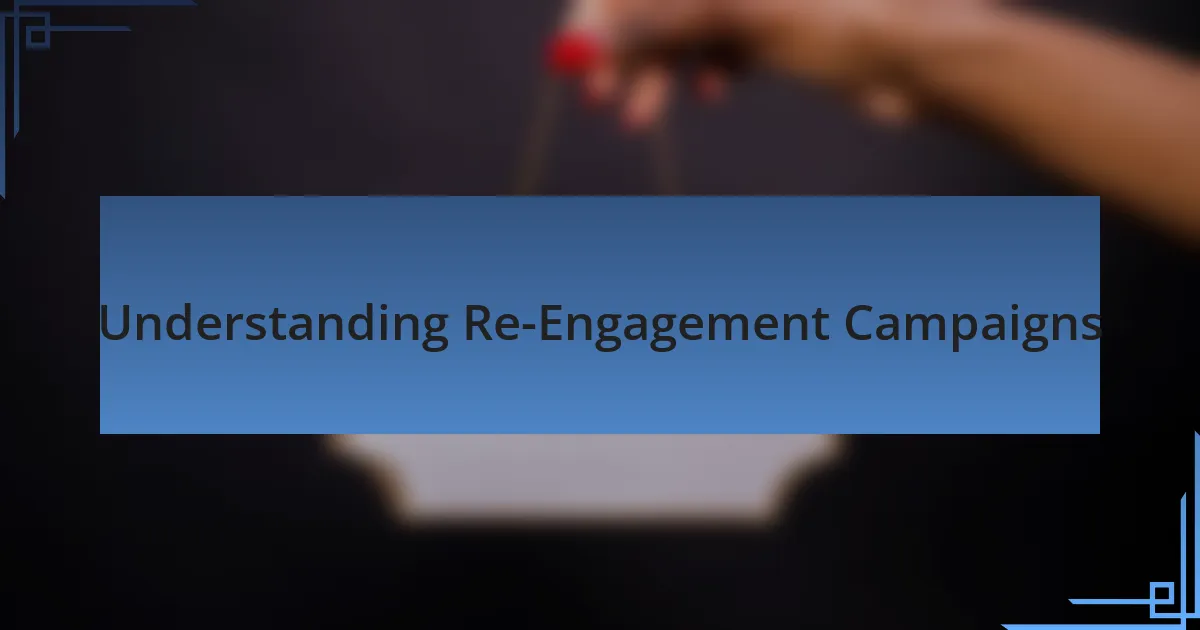
Understanding Re-Engagement Campaigns
Re-engagement campaigns are a strategic response to the challenge of customer inactivity. I remember a time when I noticed my favorite coffee shop offered a personalized deal after I hadn’t visited for weeks. It felt special, like they really cared about me, and it reminded me how powerful a tailored approach can be in rekindling customer loyalty.
These campaigns are not just about discounts; they’re about reconnecting on an emotional level. Have you ever received a heartfelt message from a brand you used to love, reminding you why you liked them in the first place? I find that these touchpoints often evoke nostalgia, reigniting my interest and encouraging me to reconnect with the brand.
In essence, re-engagement campaigns tap into the psychology of customer relationships. They seek to remind individuals of their past experiences and the value they once found. I often think about the role timing plays; sending a well-timed email can hit just when a customer could use a little reminder of what they’ve been missing. Isn’t that what we all want—to feel seen and valued in the hustle of everyday life?
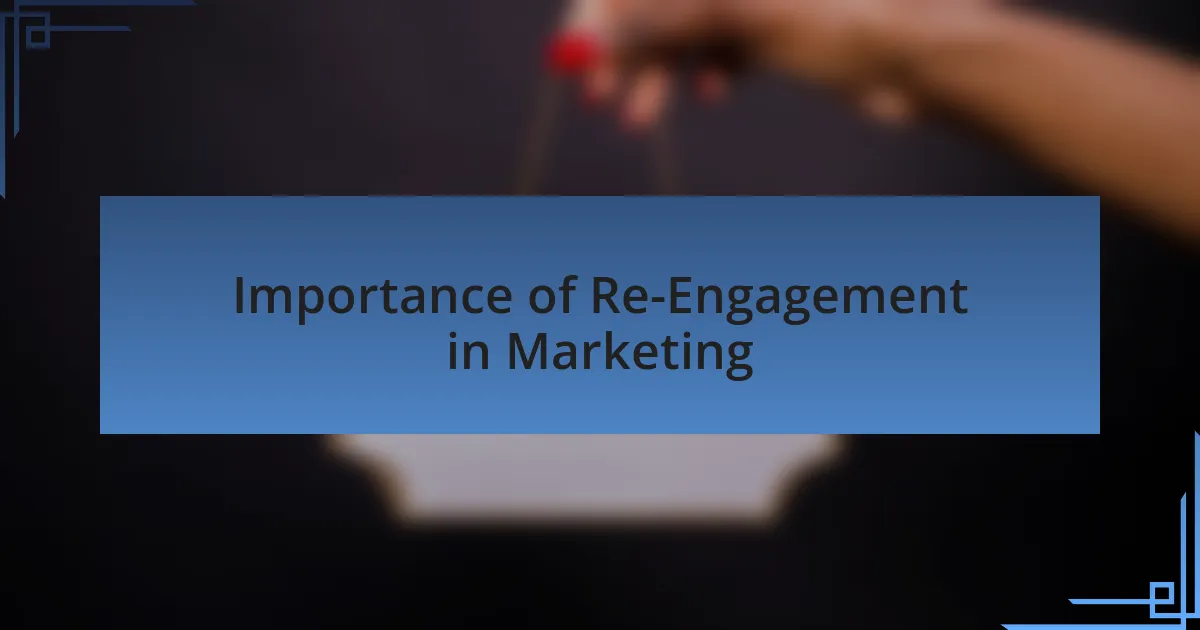
Importance of Re-Engagement in Marketing
Re-engagement is crucial in marketing because it helps regain the attention of customers who have drifted away. I vividly recall a subscription service that sent me a carefully crafted email with content based on my previous interests. It didn’t offer just another discount; it showcased new products I’d never explored, which felt tailored to my unique tastes. Isn’t it fascinating how just a thoughtful nudge can rekindle a relationship?
Moreover, re-engagement campaigns show customers that a brand values them beyond just transactions. I once received a handwritten note from a local brand I hadn’t engaged with in months, expressing gratitude for my past support. That simple gesture made me feel appreciated and prompted me to revisit their website. In a world where we often feel invisible, this acknowledgment can spark a genuine emotional connection.
The impact of these campaigns extends beyond immediate sales. They often foster long-term loyalty by reminding customers of the brand’s commitment to their satisfaction. I’ve found that involving customers in the development of campaigns—like asking for feedback or celebrating anniversaries—creates a sense of partnership. Isn’t it rewarding to feel like you’re a part of something larger? Through re-engagement, brands can not only revive interest but also cultivate lasting relationships with their audience.
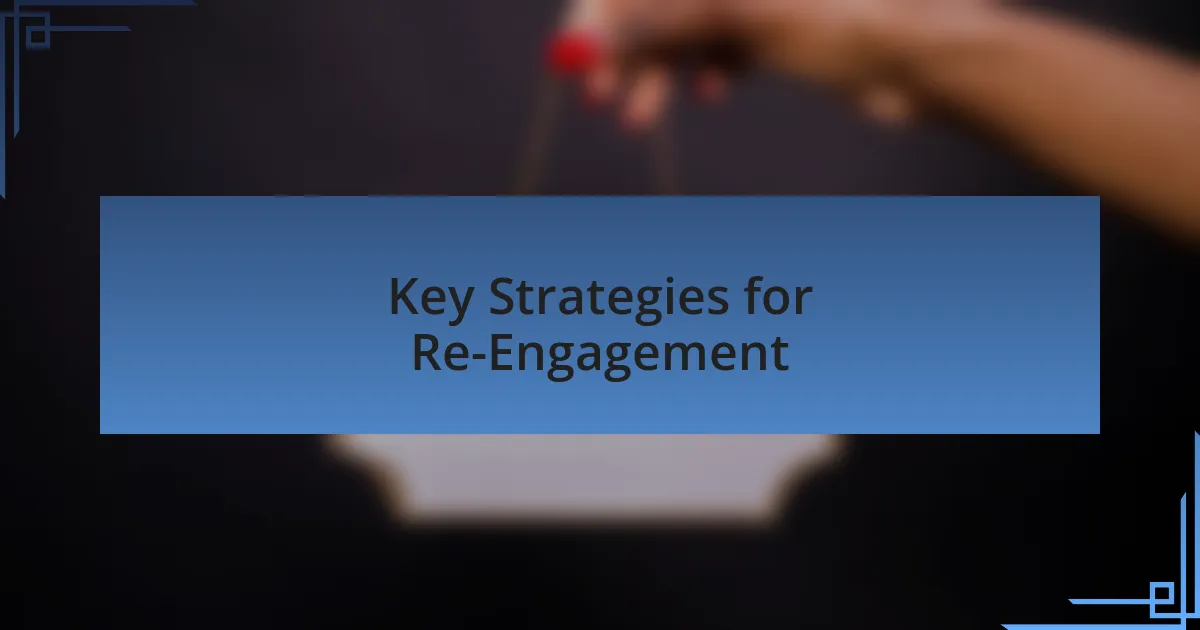
Key Strategies for Re-Engagement
One effective strategy for re-engagement is personalization. I recently subscribed to an online retailer that used my past purchase history to suggest products in their emails. It felt almost like a conversation, where they understood my needs and preferences. When have you received a similar recommendation that made you think, “Wow, they really get me”? That personal touch can turn a standard email into an engaging dialogue.
Another powerful approach is to leverage exclusive offers or content. I remember a time when a brand I hadn’t interacted with for a while sent me an invitation to a members-only webinar. It provided deep insights about a product I had liked previously. That sense of exclusivity made me feel special and reconnected me to the brand in a way that felt genuine. Have you ever been drawn back to a brand because of a unique opportunity they presented?
Lastly, timing plays a pivotal role in re-engagement. I’ve noticed that receiving a follow-up message shortly after cart abandonment or a significant period of inactivity can rekindle interest effectively. For instance, a gentle reminder about items left in my cart or an email celebrating my shopping anniversary creates urgency and curiosity. Have you noticed how timely nudges can trigger a response? By paying attention to when customers might be most receptive, brands can create impactful re-engagement strategies.
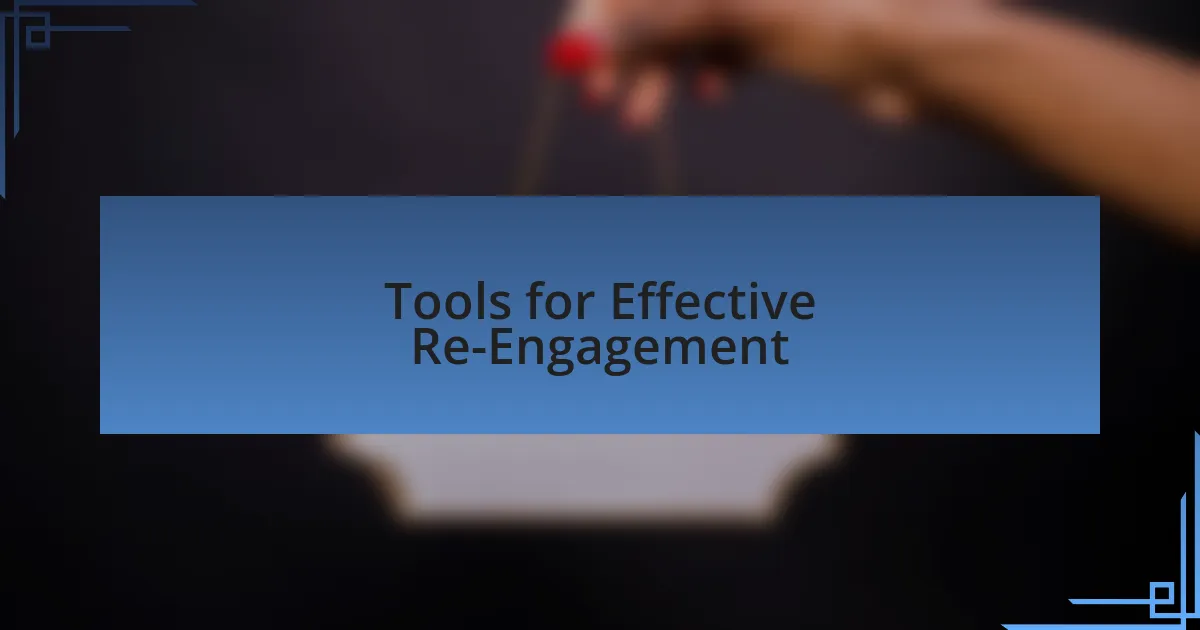
Tools for Effective Re-Engagement
To effectively implement re-engagement campaigns, I’ve found that utilizing marketing automation tools can be a game-changer. For instance, I recall using a platform that automated personalized emails based on user behavior. When I saw a follow-up email that referenced my last browsing session, it didn’t just feel automated; it felt timely and relevant. Have you ever experienced that moment of surprise when a brand remembers your interest?
Another key tool that stands out to me is customer relationship management (CRM) software. I recall a time when I worked with a client who integrated their CRM with their re-engagement efforts. By segmenting their audience based on interaction history, they were able to target customers who had previously shown interest but had gone quiet. This data-driven approach made us feel more like we were having tailored conversations rather than sending generic messages. Isn’t it fascinating how having access to the right data can transform a simple message into a meaningful outreach?
Also, don’t underestimate the power of social media platforms for re-engagement. I had a delightful experience when a brand I hadn’t interacted with in months re-emerged on my feed with compelling content that resonated with my interests. Their strategic use of social media not only rekindled my interest but also made me eager to share with friends. Have you ever reconnected with a brand through an engaging post or advertisement that caught your eye? It highlights how important it is to be present in the virtual spaces where your audience hangs out.
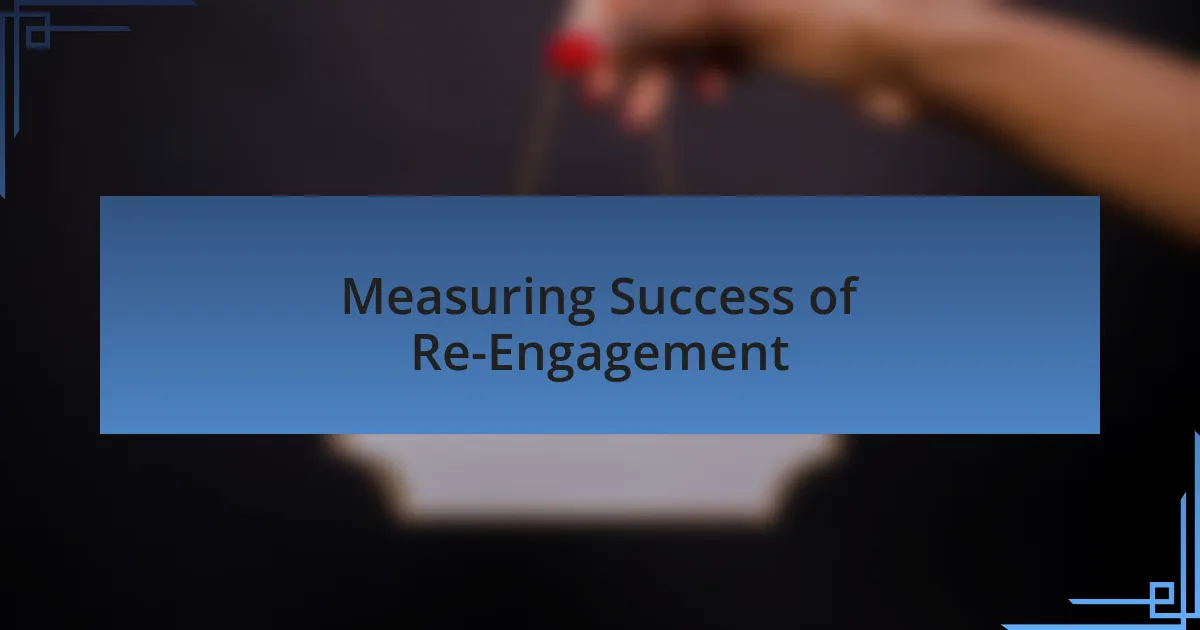
Measuring Success of Re-Engagement
Measuring the success of re-engagement campaigns can be surprisingly nuanced. I recall running a campaign for a client’s online store, where we tracked open rates and click-through rates meticulously. It was thrilling to see how a mere 5% increase in these metrics translated to a significant uptick in sales for previously disengaged customers. Have you ever felt that rush when the numbers reflect the effort you put in?
Another aspect I find crucial is analyzing customer feedback post-campaign. I remember sending a survey to users who re-engaged with our content, asking them what influenced their decision. The responses were enlightening: customers appreciated personalized messages. It drove home the point that listening to your audience isn’t just beneficial but essential. Have you ever wondered if your audience’s insights could shape your future outreach more effectively?
Lastly, conversion rates are often the gold standard in measuring re-engagement’s success, but they don’t tell the whole story. I once analyzed a campaign where conversions were steady, but the average order value increased. It made me rethink how successful interactions can manifest in various forms. Isn’t it exciting to explore different dimensions of success beyond just the numbers?
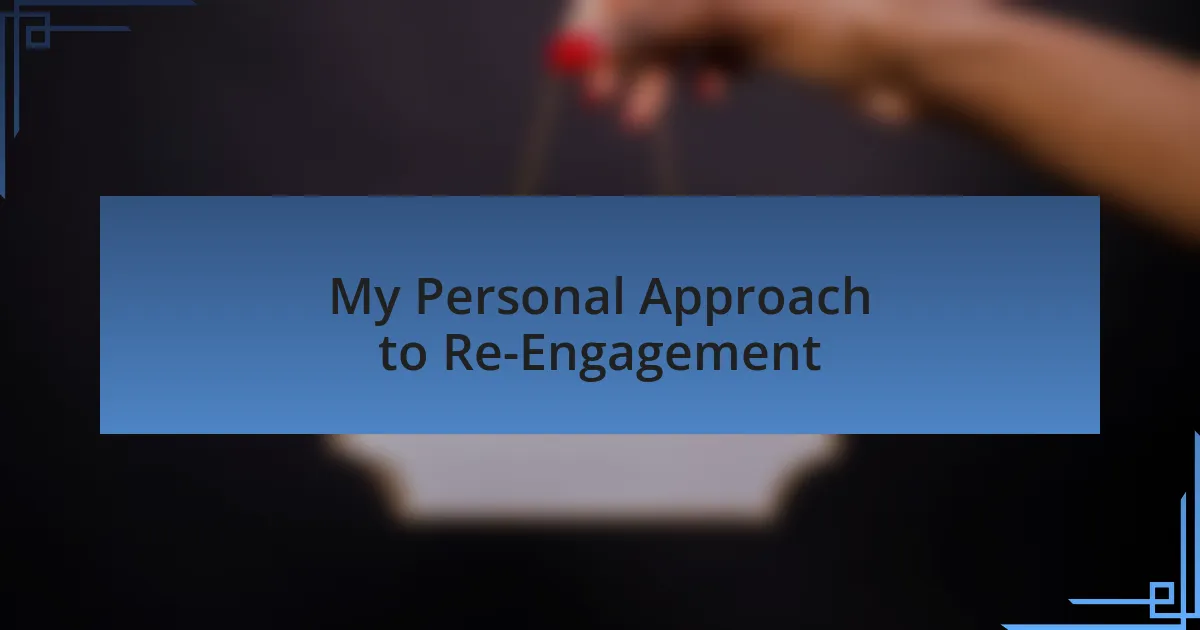
My Personal Approach to Re-Engagement
When I approach re-engagement campaigns, my first priority is to understand the unique motivations of the audience. I once analyzed a segment of users who hadn’t interacted with a brand in months. After some digging, I discovered that their interests had shifted. This revelation was a game changer. Have you ever noticed how understanding these shifts can completely alter your strategy?
I also believe in the power of tailored communication. A memorable experience for me was when I created a campaign that segmented users based on their previous interactions. Instead of sending a blanket email, we crafted messages that resonated personally with different groups. The increase in engagement made me realize: how often do we underestimate the impact of personalization in our outreach?
Finally, I embrace a mindset of continuous learning during these campaigns. Reflecting on a re-engagement effort I led, I welcomed the opportunity to test different approaches. Some ideas worked brilliantly while others flopped. This trial-and-error process not only refined my strategies but also taught me that failure is just as valuable as success. Have you ever felt the freedom that comes from experimenting with your methods?
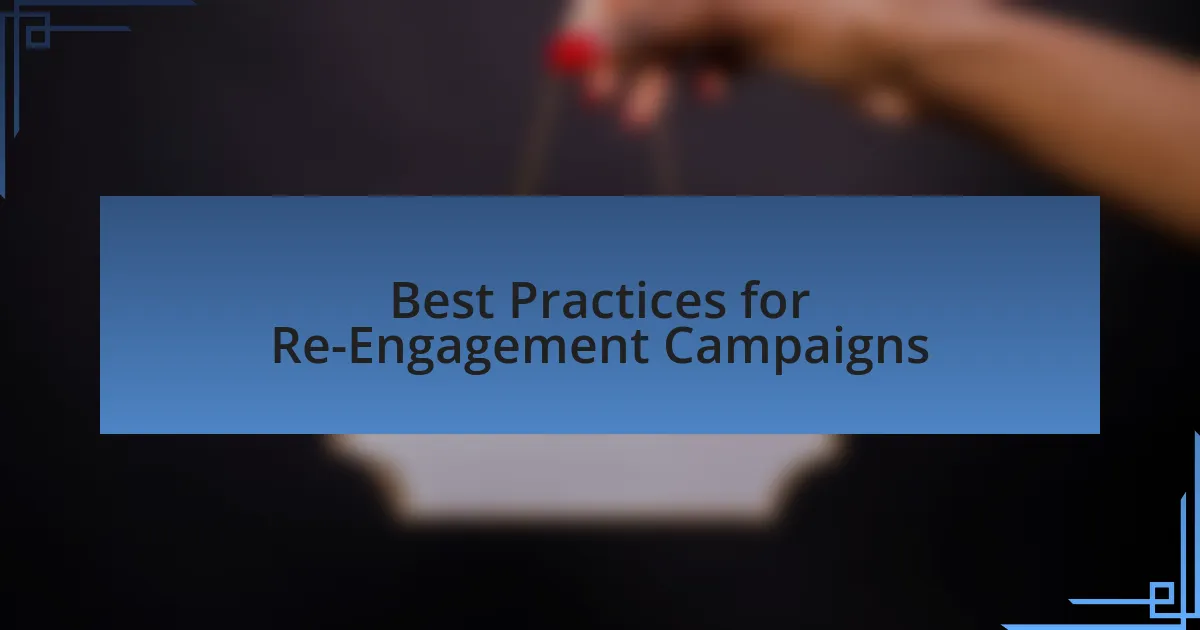
Best Practices for Re-Engagement Campaigns
Best Practices for Re-Engagement Campaigns
In my experience, timing is everything. I once launched a re-engagement campaign right after a holiday, thinking users would be fresh and excited to reconnect. However, I found that many were still in recovery mode from the festivities! Now, I try to analyze peak engagement times, ensuring we reach out when our audience is most likely to respond. Have you ever considered how timing can make or break your campaign?
Another crucial aspect is the use of compelling incentives. I remember a campaign where we offered exclusive access to a new product for returning customers. The excitement was palpable! This strategy not only brought users back but also created buzz around our brand. Have you thought about what unique value you can offer to reignite interest in your audience?
Lastly, simplifying the re-engagement process can significantly boost responses. I learned this firsthand when a complicated sign-up process deterred users from returning. Streamlining the user experience, like offering one-click reactivation, made a noticeable difference. It made me wonder: how often do we overlook the importance of convenience in keeping our audience engaged?